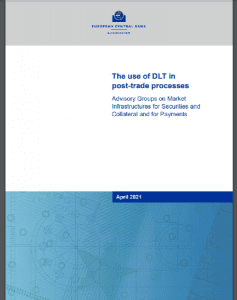
Broken into 3 main ‘chapters’ the report outlines regulatory, governance and interoperability aspects identified in the context of DLT-based solutions.
Chapter 1 also:
- outlines key elements in the regulatory framework
- defines potential new functions in the DLT environment
- explains the concept of interoperability used in the report.
Chapter 2 describes two DLT models and their key functionalities. Chapter 3 addresses the key implications of using DLT at different stages of the securities life cycle, from issuance to custody and settlement.
The ECB report
The report says it seeks to establish a common European stakeholder understanding of the progress made to date in implementing DLT in line with the current regulatory system. It focuses on current use cases for equities and bonds. The report also assesses the implications of using DLT on the basis of identified market practices.
The report describes different types of securities issuance and post-trade processes. These are categorised according to different ‘models’ depending on how DLT is used in each instance.
Examples identified in the market are presented in annexes:
- Annex 1 illustrates the models by highlighting the key components of specific solutions in the process of implementation in the market
- Annex 2 describes key examples of how interoperability can be ensured in DLT-based solutions (with brief discussions of Cosmos, Polkadot, DAML, ILP (Interledger Protocol), FUSION, Chainlink and Quant).
The importance of interoperability
As described, the use of DLT must necessarily confront challenges which:
- are similar to those faced by solutions relying on conventional technology, like fragmentation and interoperability issues
- create new ones (for example, relating to the legal validity of tokens).
For the ECB, the avoidance of additional costs and barriers – alongside existing hurdles – is a must, if it (the ECB) is to oversee the adoption of DLT-based solutions.
To mitigate the risks associated with fragmentation and interoperability, it believes its first step must be to identify a common technology-neutral taxonomy. The aim of this is to enhance clarity, including in terms of a regulatory framework.
Once such a taxonomy is available, the ECB thinks consideration can move onto specific DLT features. The focus here will be an assessment of the extent to which these might alter the dynamics of current functions:
- related life-cycle activities
- managing tasks (on or off the network)
- aggregation into smart contracts.
In the view of the ECB, “interoperability is necessary for the implementation of new financial market technologies characterised by interdependencies and network effects. To improve the use of such new technologies (both DLT and others) and to avoid further fragmentation, common protocols and standards are needed. Legacy and DLT-based systems need connection and communication standards that are robust in the face of technological innovation. This will help to:
- avoid a situation where each system becomes a different ecosystem isolated from the others
- ensure a level playing field among market participants, irrespective of the underlying technology.
“Interoperability should therefore be seen as a crucial feature when developing any post-trade solution based on DLT. It should also be a key consideration when addressing preliminary issues, such as the business design – and in some instances even the technical design – of a solution and how to link the entire chain of stakeholders and mechanisms, including end-users and existing engines/tools that need to remain accessible.”
The key point is that any DLT-based solutions must have strong governance underpinnings, such that:
- interests align
- proper monitoring occurs.
Enterprise Times: what does this mean
There are (at least) two ways to look at this report. The first is constructive. There would be an incentive for the wide-scale adoption of innovative DLT technology while ensuring safety and common rules. This matters because market standards have a critical role to play. Enterprise Times agrees with the ECB that, in the same way as for incumbent systems, interoperability remains critical in any DLT environment both for:
- migrating efficiently from an incumbent system to a DLT-based system
- connecting DLT-based systems and incumbent systems on an ongoing basis.
In addition, the examples and Annexes are of particular use.
That said, the notion of first preparing an agreed taxonomy fills Enterprise Times with gloom. While there is nothing wrong with a common taxonomy in itself, this feels like a common EU tactic – kicking the ball into the long grass and hoping that time will solve the problem. In the judgement of Enterprise Times, the ECB should not permit this to happen, or it will find itself left long behind, operating in the type of post-trade circumstances it itself denigrates.


























